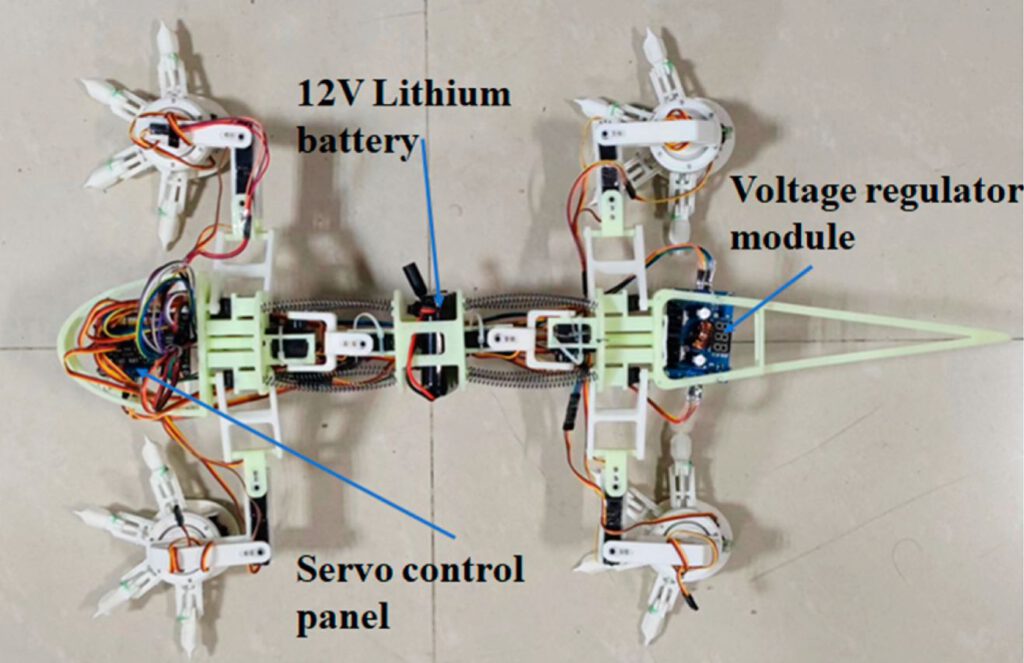Mars exploration vehicles are usually equipped with wheels, allowing them to traverse some of the challenging terrains of the Red Planet. But eventually those systems start to wear out and one of the wheels gets stuck. The 2009 “Free Spirit” campaign is the most widely known case. Unfortunately, that campaign was not successful and now, 15 years later, Spirit remains stuck in its final resting place. Things might have been different if NASA had adopted a new robotics paradigm developed by Guangming Chen and his colleagues at the Institute of Mobile Bioinspiration and Intelligent Robotics at Nanjing University of Aeronautics and Astronautics. They came up with a robot based on a desert lizard, with adaptable legs and a flexible “spine” that, according to their calculations, is well suited to traverse on the Martian regolith.
Planning for traversing tough terrain isn’t unique to the stuck rover: Perhaps the two best-known rovers active on Mars, Curiosity and Perseverance, currently spend a lot of their time avoiding areas where they might get tangled, limiting their ability to gather data from those areas and potentially missing cool rocks like the pure sulfur that Curiosity recently discovered for the first time on Mars.
Lizard-inspired robots, on the other hand, would have no problem traversing such terrains, and they also have some advantages when it comes to traversing rocky and other varied terrains: Most rovers don’t have enough leg lift to get over medium-sized rocks, but legged robots, especially those with adjustable “toes,” can get a better grip on rocks than regular legged robots.
Lizard-inspired robots can not only walk, but also jump like their biological kin, as demonstrated in this video from the University of California, Berkeley’s Robotics Laboratory.
Credit – University of California, Berkeley YouTube Channel
The robot itself is a relatively simple design. It has four “legs” offset from one another by a chassis that essentially resembles a desert lizard. It also has a tail for balance. Each foot has three spring-loaded “toes”, as well as servos to drive the ankle joints and bearings for rotational control. This combination allows the lizard robot to effectively walk on all fours, optimally adjusting each leg to the surface it’s “walking” on.
The authors performed a series of kinematic calculations for different types of terrain, allowing them to understand how the robot would interact with each surface. Kinematic calculations are typically used in robotics when designers are trying to figure out the optimal way to move a particular robot part. In this case, the calculations are relatively detailed, given the number of moving parts. However, it is possible to run the control algorithms using only on-board computation, allowing for basic autonomous terrain navigation if the architecture is adopted for space use.
Building a physical prototype is a great way to work on its navigation algorithms, and that’s exactly what the researchers did: They 3D printed many of the chassis and foot parts, built batteries and controllers into the head and tail sections, and began testing the prototype on simulated Martian test terrain.
Mars isn’t the only place that could benefit from legged robots: As Fraser argues, they could even function on the Moon.
They tested everything from gripping loose regolith to climbing over small rocks, and their algorithms seemed to work effectively to handle the relatively simple terrain of the testbed, but the robot’s actual movement speed was slower than initially simulated, mainly due to the technical difficulties of balancing the movement of the springs and spine.
Despite the issues they encountered during physical testing, this new iteration of the robot is a step in the right direction; the lab has been designing similar systems for years. They also plan to continue developing another version, including installing a continuous power source and fully implementing autonomous navigation algorithms. Their research is funded by both Jiangsu province and the Chinese Ministry of Science and Technology, so it looks like they’ll continue to get support, at least for the time being.
learn more:
Chen et al. – Developing a lizard-inspired robot for Mars surface exploration
UT – Spirit Rescue, Day 1: Drive stops after 1 second
UT – Biomimicry and Space Exploration
UT – Robots may fly around and explore the moon.
Lead image:
An image of the prototype biomimetic lizard robot.
Credit – Chen et al.
like this:
Like Loading…

